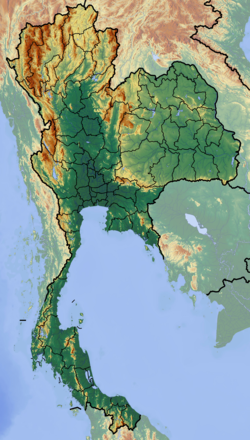ബാൻ ചിയാങ്ങ്
 | |
| യുനെസ്കോ ലോക പൈതൃക സ്ഥാനം | |
|---|---|
| സ്ഥാനം | തായ്ലാന്റ് |
| Area | 30, 760 ഹെ (3,200,000, 81,800,000 sq ft) |
| മാനദണ്ഡം | iii[1] |
| അവലംബം | 575 |
| നിർദ്ദേശാങ്കം | 17°32′55″N 103°21′30″E / 17.548611111111°N 103.35833333333°E |
| രേഖപ്പെടുത്തിയത് | 1992 (16th വിഭാഗം) |
തായിലാണ്ടിലെ ഉഡോൺ താനി പ്രവിശ്യയിലെ നോങ്ങ് ഹാൻ ജില്ലയിലെ ഒരു പുരാവസ്തു പഠനകേന്ദ്രമാണ് ബാൻ ചിയാങ്ങ്(Thai: แหล่งโบราณคดี บ้านเชียง).1992-ൽ യുനേസ്ക്കോ ഈ സ്ഥലത്തെ ലോക പൈതൃക കേന്ദ്രങ്ങളിൽ ഒന്നായി തിരഞ്ഞെടുത്തു.1966-ൽ കണ്ടെത്തിയ ഈ സ്ഥലം, ചുവന്ന മൺകലങ്ങളുടെ പേരിൽ വളരെ പ്രശസ്തമാണ്.
കണ്ടെത്തൽ
[തിരുത്തുക]
ഗ്രാമീണർ താമസിച്ചിരുന്ന് ഈ സ്ഥലത്തെ പറ്റി വളരെ വർഷക്കാലം ആർക്കും ചരിത്ര പ്രാധാന്യം മനസ്സിലായിരുന്നില്ല. ഹാർവാർഡ് കോളേജിൽ നരവംശശാസ്ത്രം പഠിക്കുകയായിരുന്ന സ്റ്റീവ് യംഗ് അവിടെ 1966-ൽ താമസിക്കുകയായിരുന്നു.വില്യം സോൽഹൈം തെക്ക്-കിഴക്കൻ ഏഷ്യയിൽ നാഗരികതകളുടെ ഉദ്ഭവത്തെ പറ്റിയുള്ള സാധ്യതകൾ പറഞ്ഞിരുന്നത് സ്റ്റീവ് ശ്രദ്ധിച്ചിരുന്നു.ഒരു ദിവസം ബാൻ ചിയാങ്ങിലൂടെ സഹായിയായ ഗ്രാമത്തിലെ കലാ അദ്യാപകനുമായി സഞ്ചരിക്കവെ കപോക് മരത്തിന്റെ വേരിൽ തട്ടി ചെളിയിൽ വീണു.അവിടെ നിന്ന് അദ്ദേഹം ചെറുതും മധ്യ വലിപ്പവുമായിട്ടുള്ള ധാരാളം മൺകലങ്ങൾ കണ്ടെത്തി.അവ പരിശോദിച്ചതിൽ നിന്ന് ആദ്യ കാലത്ത് തന്നെ തീചൂളയിൽ നിന്ന് കലങ്ങൾ നിർമ്മിക്കാനുള്ള വിദ്യ അവിടങ്ങളിൽ താമസിച്ചിരുന്നവർ സ്വന്തമാക്കിയിരുന്നതായി യംഗ് മനസ്സിലാക്കി.എന്നാൽ കലങ്ങളുടെ പുറത്തെ ഡിസൈൻ വ്യത്യസ്തവും മനോഘരവുമായിരുന്നു.അദ്ദേഹം കലങ്ങളിൽ ചിലത് അദ്ദേഹം ഫാന്തിപ് ചുംബോതെ രാജകുമാരനു അയച്ച് കൊടുത്തു.അദ്ദേഹത്തിന് ബങ്കോങ്ങിൽ സ്വകാര്യമായി ‘സുവാൻ പക്കാഡ്’ മ്യൂസിയമുണ്ട്.യംഗ് കുറച്ച് കലങ്ങളെടുത്ത് തായി സർക്കാരിന്റെ ഫൈൻ ആർട്സ് ഡിപ്പാർട്ട്മെന്റായ ‘ചിൻ യു ഡി’യിലേക്കും അയച്ചു കൊടുത്തു[2].പിന്നീട് ഫോർഡ് ഫൗഡേഷന്റെ സ്റ്റാഫായ കലാ ചരിത്രകാരനായ എലിസബത്ത് ലിയോൺസ് ബാൻ ചിയാങ്ങിൽ നിന്ന് വസ്തുക്കൾ പെൻസിൽവാനിയ സർവകലാശാലയിലേക്ക് കാല നിർണ്ണയത്തിനായി അയച്ചു കൊടുത്തു.
പുരാവസ്തുക്കൾ
[തിരുത്തുക]1967-ലെ ആദ്യത്തെ ശാസ്ത്രീയ ഖനനത്തിൽ നിന്ന് പല അസ്ഥികൂടങ്ങളും അവയോടൊപ്പം ചെമ്പ് ശവക്കല്ലറയും കുഴിച്ചെടുത്തു.അവിടെ നിന്നും നെല്ലിന്റെ അംശങ്ങളും കണ്ടെത്തി[3] .
അധിക വായനയ്ക്ക്
[തിരുത്തുക]- Higham, Charles, Prehistoric Thailand, ISBN 974-8225-30-5, pp 84–88
- Higham C.F.W. and T.F.G. Higham 2009. A new chronological framework for prehistoric Southeast Asia, based on a Bayesian model from Ban Non Wat. Antiquity 82:1-20.
- Higham C.F.W. 2011. The Bronze Age of Southeast Asia: new insight on social change from Ban Non Wat. Cambridge Archaeological Journal 21(3): 365-89
- Higham C.F.W., R. Ciarla, T.F.G. Higham, A. Kijngam and F. Rispoli 2011. The establishment of the Bronze Age in Southeast Asia. Journal of World Prehistory, 24 (4),227-274:
- Higham C.F.W., T.F.G. Higham and A. Kijngam 2011. Cutting a Gordian Knot: The Bronze Age of Southeast Asia, timing, origins and impact. Antiquity 85:583-98.
- White, J.C. and Hamilton, E. G. 2009. The Transmission of Early Bronze Technology to Thailand: New Perspectives World Prehistory (2009) Vol. 22. Pp 357–397
- White, J. C. (1995). Incorporating Heterarchy into Theory on Socio‐political Development: The Case from Southeast Asia. Archeological Papers of the American Anthropological Association, 6(1), 101-123.
- ↑ http://whc.unesco.org/en/list/575.
{{cite web}}: Missing or empty|title=(help) - ↑ Southeast Asia: A Past Regained, Time-Life Books, Alexandria, Virginia 1995, pages 25–32
- ↑ British Museum Collection [1]
- Pietrusewsky, Michael; Douglas, Michele T. (Michele Toomay) (Fall 2001). "Intensification of Agriculture at Ban Chiang: Is There Evidence from the Skeletons?" (PDF). Asian Perspectives. 40 (2). Project MUSE: University of Hawai'i Press: 157–178. doi:10.1353/asi.2001.0023. ISSN 0066-8435. e-issn 1535-8283. Retrieved 21 September 2011.
Abstract: Human skeletal remains excavated in 1974 -1975 at Ban Chiang, a premetal to Bronze/Iron Age site located in northeastern Thailand, are used to examine the health effects of sedentism and agricultural intensification. The archaeological sequence provides evidence for the introduction of iron and water buffalo in the Middle period, suggesting the beginning of intensified agriculture. The effects of this agricultural intensification on the paleodemography, health, and patterns of traumatic injury of Ban ChiangÕs early inhabitants is examined. The skeletal and dental attributes examined include palaeodemographic parameters, dental caries, dental enamel hypoplasia, cribra orbitalia, stature, skeletal infections, and trauma. The results of this analysis are mixed. There are decreases in life expectancy and mean age-at-death that are consistent with a decline in health over time, but evidence for an increase in fertility, expected with intensified agriculture, is not found. Expected temporal increases in dental enamel hypoplasia and adult cribra orbitalia are documented. However, the expected decline in adult stature and expected increases in dental caries, cribra orbitalia in subadults, skeletal infection, and traumatic injury are not found. Overall, the skeletal indicators support continuity in Ban Chiang health, suggesting continuous reliance on a broadly based subsistence system. These findings do not fit the typical pattern demonstrated for other human groups experiencing the transition to sedentism and intensified agriculture and may support the contention that Southeast Asia's archaeological sequence differs markedly from those studied elsewhere in the world.
പുറത്തെക്കുള്ള കണ്ണികൾ
[തിരുത്തുക]- This Ancient Land of Dinosaurs, Siamoid, Siamese, and Thais Part III
- "The Discovery of Ban Chiang" [2] Archived 2011-07-20 at the Wayback Machine.
- The Ban Chiang project Archived 2010-03-07 at the Wayback Machine. at the University of Pennsylvania
- Ban Chiang gallery Archived 2002-03-23 at the Wayback Machine. at the University of Hawai'i
- UNESCO world heritage listing
അവലംബം
[തിരുത്തുക]17°32′55″N 103°21′30″E / 17.54861°N 103.35833°E


